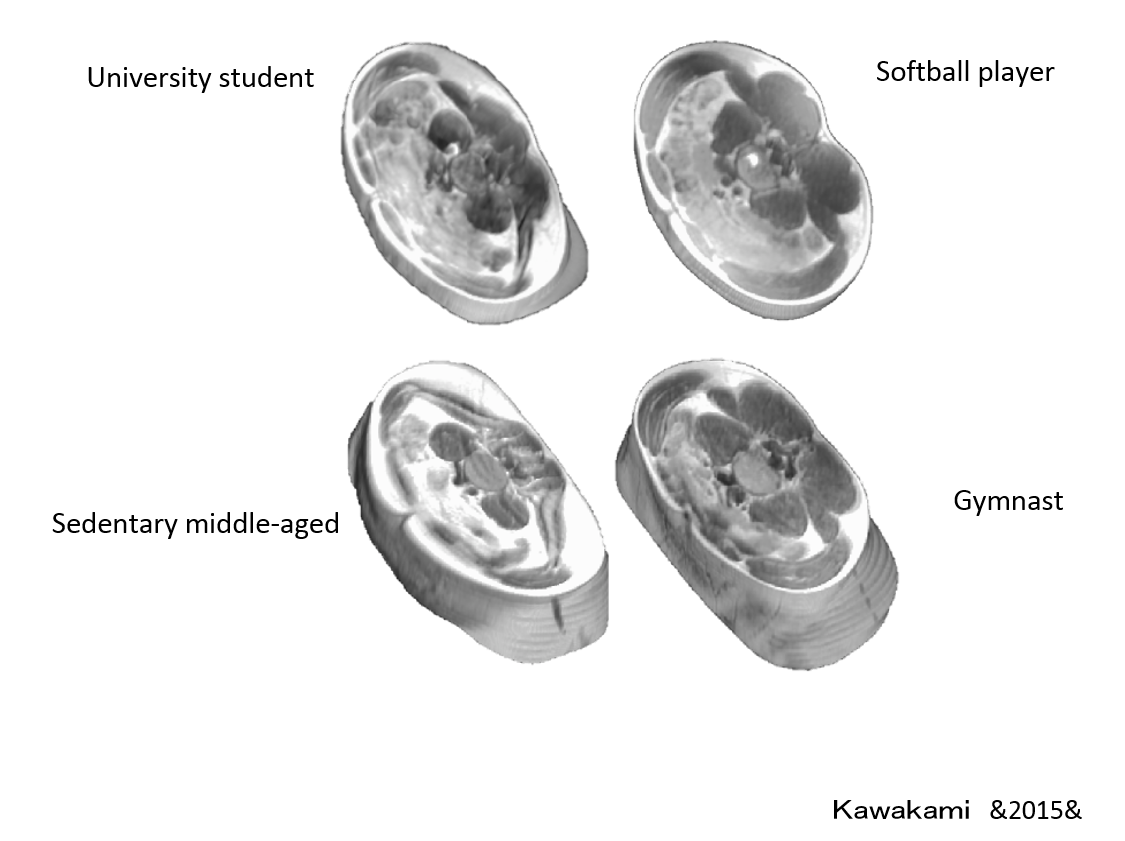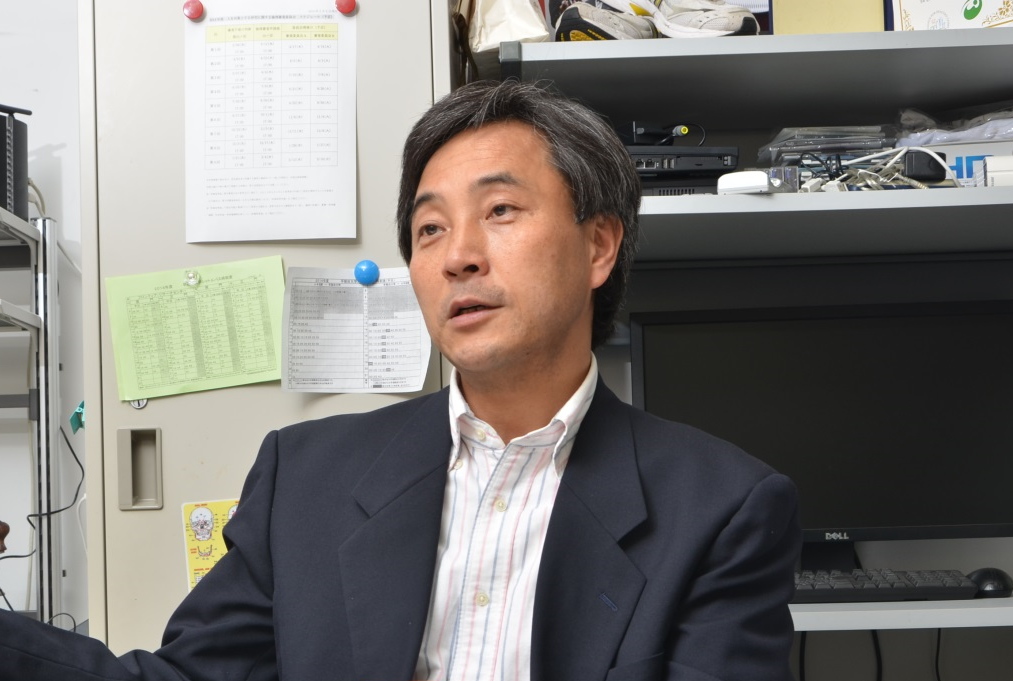Waseda Frontline Research Vol. 7, Part 1 – Can science win medals? Using science at the 2020 Tokyo Olympics!
Tue, Jan 19, 2016-
Tags
Exercise physiology and biomechanics researcher
Professor Yasuo Kawakami, Faculty of Sport Sciences
Winning medals with science – The search for body mechanisms

The Olympic Games are returning to Tokyo in 2020, nearly half a century after the 1964 Tokyo Olympics. One researcher sees the 2020 Olympics as a landmark event in the history of Japanese sports. His name is Yasuo Kawakami, a professor at Waseda University’s Faculty of Sport Sciences, and his goal is to “win medals with science.” What kind of science does he intend to use at the Olympics? We spoke with him to get his opinion on biomechanics in sports.
Changing the world of sports with science
I specialize in human biomechanics. Biomechanics is the study of the structure and function of biological systems.
I have decided to try and “win medals with science” at the 2020 Tokyo Olympic and Paralympic Games. If my colleagues and I can use the power of science to support athletes at the Tokyo Olympics and Paralympics, our research will receive worldwide attention. My dream is to use my research to help athletes excel during and after the Olympics. Japan should lead the world in advancing the development of sports and science, and the Tokyo Games provide the perfect opportunity to do so.
Allow me to provide a brief overview of my research. Photo 1 below shows a cross-sectional image of my own body taken with an MRI scanner. I have also taken various measurements of the human body using ultrasonic waves, lasers, etc. to study specific aspects of the human body in detail. The general approach of my laboratory is using biometrics to understand the physique and mechanisms of the human body. Photo 2 are cross-sectional images of the human stomach of various people. One’s stomach gives us insight into the kinds of sports the individual plays, as well as their lifestyle patterns. The development of one’s muscles, along with the accumulation pattern of adipose tissue, can give us a general idea of what type of exercise that person is doing, and what sort of lifestyle they are living.
Furthermore, we now have a clear understanding of whether muscle changes become more difficult or easier as one grows older. We can use this information to alter the human physique, so that the physique itself can express energy. Through various types of biometric research, we can clarify the acquisition process of human sports performance, and establish methods to evaluate and prevent metabolic syndrome and other disorders in junior high and high school aged individuals.
In recent years, science and technology have made significant inroads in the world of sports. For example, by using motion capture, the same technology used in movies, athletes can objectively observe their own movement and form, such as during a 100-meter dash. However, motion capture data will not necessarily have a direct correlation in improving an athlete’s time in the 100-meter dash. There’s no doubt that it provides significant support to improving one’s competitive ability, but I don’t think there is any research out there right now that shows any specific or direct contribution to such improvement. Using my research, I hope to pioneer a revolution in sports through science.

(Photo 1) An MRI image of Professor Kawakami’s body (source: Yasuo Kawakami)

Measuring the fight-or-flight response and the world’s fastest men
I would like to make the 2020 Tokyo Olympics and Paralympics an opportunity to use biometric results to “search for mechanisms in physical exercise,” and to “develop physical fitness support gear.”
First, I would like to talk about the search for mechanisms in physical exercise, and save gear development for later. The aim of this research is to verify what sort of mechanisms make the human body function.
You have probably heard of the “fight-or-flight response.” This reactionary response gives the body increased strength and speed in anticipation of fighting or running away. This phenomenon really exists, but what sort of mechanisms are behind this sudden burst in strength?
The quadriceps of an adult male’s thighs are capable of exerting about one ton of power and skeletal muscles are capable of incredible strength. However, in some cases, using such tremendous power can injure the muscles. This is the dreaded “torn” or “pulled” muscle. To prevent this, the cerebrum acts as an instructional apparatus, causing the muscles to contract, and limiting their output. However, in an extremely intense situation, such as in the scene of a fire, the body shuts down the limiter, which triggers a tremendous burst of strength in the muscles. Although it rarely shuts down, the limiter (the cerebrum) allows for extremely high levels of strength in power athletes (cerebrum excitement levels are high when strength is exerted).
An experiment where electrical stimulation forces muscles to contract when at 100% power demonstrated that the upper limit of strength is higher than when no there is no electrical stimulation (Figure 1). Virtually no electrically stimulated increase is detected when performed on a subject with a high-level limiter (top of Figure 1).
 However, sports require simultaneous movement of many muscles at appropriate intervals, which is very difficult. I am sure all of us have been embarrassed at one time or another in short-distance running or jumping events where we were unable to perform at full strength. However, being able to consistently perform at one’s best day in and day out is difficult for even the greatest of athletes.
However, sports require simultaneous movement of many muscles at appropriate intervals, which is very difficult. I am sure all of us have been embarrassed at one time or another in short-distance running or jumping events where we were unable to perform at full strength. However, being able to consistently perform at one’s best day in and day out is difficult for even the greatest of athletes.
I was fortunate enough to be able to measure the physique and athletic abilities of the fastest sprinters in the world. I used MRI and ultrasonic analysis to find the differences between short-distance runners Asafa Powell and Usain Bolt.
The stomachs of black athletes tend to protrude out slightly. This is due to a developed greater psoas muscle between the organs and the spine. I noticed that the psoas major muscle in Powell and Bolt are developed to a superhuman degree. They are so developed that they push the athletes’ organs aside. This feature is one reason Usain Bolt has been nicknamed the Lightning Bolt.
However, it is not the only reason. It is important to note that these sprinters have a physique that perfectly matches their body functionality. Such a match is essential for their athletic performance. Although Japanese sprinters’ physiques do not match those of black athletes, Japanese sprinters’ best time is only 0.5 seconds slower, for a difference of no more than 5%. Although there is an obvious difference in physique and muscle strength, they are very close in terms of performance. I believe this is due to the exceptionable match between Japanese athletes’ physique and body functionality. Therefore, although Powell and Bolt are exceptional athletes, they are not on an entirely different plane of existence. I believe we can enable Japanese athletes to “win medals with science” If we are able to determine the mechanisms behind what makes the Japanese athlete fast and strong, and utilize that knowledge to develop effective training techniques.
Please look forward to the next part of this volume titled “Winning Medals with Science – Gear Development and Revolutionary Coaching”.
Click here for Part 2
Click here for Part 3
Click here for Part 4
Profile

Yasuo Kawakami graduated from the University of Tokyo with a degree from the Faculty of Education’s Division of Physical and Health Education (Physical Education Course) in 1988. In 1990, he acquired a Master’s Degree from the University of Tokyo’s Graduate School of Education and withdrew from the doctoral program in 1991. In 1991, he worked as an assistant at the University of Tokyo’s College of Arts and Sciences, in the Department of Health and Physical Education. In 1996, he worked as an assistant at the University of Tokyo’s Graduate School of Arts and Sciences in Multi-Disciplinary Sciences, and was promoted to assistant professor in 1999. In 2003, he became an assistant professor at Waseda University’s School of Sport Sciences. He became a professor at Waseda University’s Faculty of Sport Sciences in 2005.
Accomplishments and research
-
2015~,川上筋腱特性開拓プロジェクト, 人間の筋腱特性とその可塑性に関する包括的研究:身体運動能力との関連性からみた効果的なトレーニング方策の確立に向けて(中核研究者課題)
- 2012~2015,身体運動のメカニズムと適応性の解明:骨格筋・腱動態の生体計測によるアプローチ(科研費課題)
- 2009~2011,筋肉痛の発生機序と部位特異性:筋肉痛を抑えながら筋力増強効果を高めるトレーニング(科研費課題)
Reference
- Ema, R., Wakahara, T., Yanaka, T., Kanehisa, H., Kawakami, Y. Unique muscularity in cyclists’ thigh and trunk: a cross-sectional and longitudinal study. Scand. J. Med. Sci. Sports, 2015. doi: 10.1111/sms.12511.
- Miyamoto, N., Kawakami, Y. No graduated pressure profile in compression stockings still reduces muscle fatigue. Int. J. Sports Med. 36: 220-225, 2015. doi: 10.1055/s-0034-1390495.
- Sakaguchi, M., Shimizu, N., Yanai, T., Stefanyshyn, D., Kawakami, Y. Hip rotation angle is associated with frontal plane knee joint mechanics during running. Gait & Posture 41: 557-561, 2015. doi:10.1016/j.gaitpost.2014.12.014
- Shishida, F., Sakaguchi, M., Sato, T., Kawakami, Y. Technical principles of Atemi-waza in the first technique of the Itsutsu-no-kata in Judo: from a viewpoint of Jujitsu-like Atemi-waza. Sport Science Research 12: 121-136, 2015.
- Akagi, R., Iwanuma S., Hashizume, S., Kanehisa, H., Fukunaga, T., Kawakami, Y. Determination of contraction-induced changes in elbow flexor cross-sectional area for evaluating muscle size-strength relationship during contraction. J. Strength Cond. Res. 29: 1741-1747, 2015.
- Wakahara, T., Ema, R., Miyamoto, N., Kawakami. Y. Increase in vastus lateralis aponeurosis width induced by resistance training: implications for a hypertrophic model of pennate muscle. Eur. J. Appl. Physiol. 115: 309-316, 2015.
- Sugisaki, N., Wakahara, T., Murata, K., Miyamoto, N., Kawakami, Y., Kanehisa, H., Fukunaga, T. Influence of muscle hypertrophy on the moment arm of the triceps brachii muscle. J. Appl. Biomech. 31: 111-116, 2015. doi: 10.1123/jab.2014-0126.
 This interview took place at Tokorozawa Campus, home to the Faculty of Human Sciences and the Faculty of Sport Sciences
This interview took place at Tokorozawa Campus, home to the Faculty of Human Sciences and the Faculty of Sport Sciences














